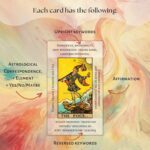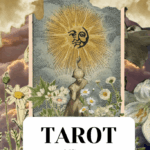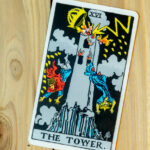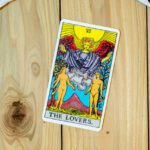The Major Arcana consists of 22 cards that chronicle the journey of the fool through the tarot deck. Each card embodies distinct life lessons, archetypal figures, and profound themes that collectively encapsulate the human experience. Understanding the meaning of these cards is crucial for tarot interpretation and provides insights into the unconscious motivations that guide our choices. Below follows a detailed breakdown of each card within the Major Arcana, elucidating their fundamental meanings, symbolism, and implications.
0. The Fool – This card represents new beginnings, spontaneity, and potential. Symbolizing the essence of adventure, The Fool encourages embracing the unknown, allowing for a fresh start. The imagery often depicts a young figure standing at the edge of a precipice, signifying the leap of faith required to embark on new journeys. The Fool is a call to trust in oneself and take risks unencumbered by fear.
I. The Magician – The Magician embodies manifestation and resourcefulness. This card signifies the mastery of skills and the ability to turn intentions into reality. Equipped with tools representing the four elements, the Magician teaches us that we possess the power to create our destiny through will and determination. It urges one to recognize and utilize their talents effectively.
II. The High Priestess – Representing intuition, mystery, and subconscious knowledge, The High Priestess serves as a bridge between the conscious mind and the deeper, more enigmatic truths within. She calls for introspection, emphasizing the importance of trusting one’s inner voice over external influences. The High Priestess is often depicted with a veil, indicating the hidden aspects of the psyche that await discovery.
III. The Empress – This card embodies femininity, beauty, and abundance. The Empress signifies growth, nurturing, and fertility in various forms. Often visualized in a lush setting, she symbolizes the productive qualities of nature and creativity. Her presence may indicate the flourishing of projects or relationships, inviting one to cultivate and appreciate what brings joy and comfort.
IV. The Emperor – The Emperor represents authority, structure, and stability. He stands as a figure of leadership and control, symbolizing the importance of discipline and order. When this card appears, it often implies the need to establish boundaries or to take charge of one’s life. The Emperor encourages developing a sense of responsibility, while also respecting hierarchy and tradition.
V. The Hierophant – This card is a symbol of tradition, spiritual guidance, and adherence to established beliefs. The Hierophant encourages one to seek wisdom through communal or institutional knowledge. Often depicted in a teaching position, he represents the transmission of wisdom as well as the importance of faith and conventional values in navigating the spiritual journey.
VI. The Lovers – The Lovers signify love, harmony, and union. They reflect not only romantic relationships but also represent choices and moral dilemmas. This card encourages one to examine the balance between individual desires and commitments. The Lovers also underscore the importance of mutual respect and understanding within partnerships, highlighting relational dynamics.
VII. The Chariot – The Chariot signifies willpower, determination, and triumph over obstacles. It depicts a figure in a chariot pulled by opposing forces, symbolizing the need to harness energies effectively to achieve goals. This card emphasizes the importance of confidence and assertiveness in navigating challenges, advocating a balanced approach to confront adversity.
VIII. Strength – Strength embodies courage, resilience, and inner strength. Rather than pleading brute force, this card suggests that true power lies in compassion and patient endurance. The imagery often features a woman gracefully taming a lion, reminding us that gentleness can conquer fear and uncertainty. Strength teaches the value of fortitude and heart in overcoming personal struggles.
IX. The Hermit – The Hermit symbolizes introspection, solitude, and guidance. He represents the quest for inward understanding, often embarking on a spiritual journey away from the chaos of the world. The Hermit encourages individuals to seek wisdom within their own inner sanctum and to embrace the lessons that solitude can teach.
X. Wheel of Fortune – This card illustrates the cycles of life, destiny, and the intricate dance of fate. The Wheel of Fortune signifies change and evolution, indicating that circumstances are in constant motion. It serves as a reminder that life’s ebbs and flows are essential to personal growth and may prompt a reflection on the unpredictable nature of existence.
XI. Justice – Justice represents fairness, truth, and accountability. It emphasizes the importance of making decisions based on ethical considerations while weighing consequences and actions. This card may indicate the resolution of disputes, advocating for balance in one’s life and within relationships while urging one to take responsibility for their choices.
XII. The Hanged Man – Depicting suspension and sacrifice, The Hanged Man signifies a pause for reflection and a change in perspective. This card encourages letting go of control and embracing the power of surrender. It invites contemplation of life’s complexities and highlights the need for patience in situations that require reevaluation.
XIII. Death – Contrary to its foreboding name, Death signifies transformation, endings, and new beginnings. It denotes the conclusion of one chapter to make way for another and urges acceptance of inevitable change. The Death card implores letting go of what no longer serves to embrace growth and renewal.
XIV. Temperance – Temperance embodies balance, moderation, and harmony. It signifies the art of blending opposing forces to create equilibrium. This card encourages individuals to practice patience and compromise, fostering a sense of unity within themselves and with others. It speaks to the importance of finding the middle path and avoiding extremes.
XVI. The Tower – The Tower represents upheaval, revelation, and sudden change. Often associated with chaos, this card urges one to confront uncomfortable truths and shatter illusions. The imagery of the tower being struck down symbolizes the need for destruction to pave the way for renewal, urging individuals to embrace transformative experiences as part of their journey.
XVII. The Star – The Star signifies hope, inspiration, and spiritual clarity. It embodies the promise of peace and serenity following tumultuous times. Often depicted with a bright star shining above, this card encourages one to look toward the future with optimism, highlighting the importance of faith in oneself and the universe.
XIII. The Moon – The Moon represents intuition, dreams, and the unconscious mind. It invites exploration of one’s innermost fears and desires, highlighting the significance of navigating the obscurity of existence. This card encourages exploring the depths of emotions and confronting illusions that may obscure reality.
XX. The Sun – The Sun embodies joy, success, and vitality. It signifies positivity and the illumination of truth, inviting a celebration of accomplishments. The Sun radiates warmth, encouraging individuals to embrace their potential and share their light with others, fostering a sense of community and engagement.
XXI. Judgment – Judgment signifies rebirth, renewal, and self-evaluation. It urges individuals to reflect on their actions and embrace personal evolution. This card often indicates a call to embrace one’s higher self, summoning the courage to make necessary changes that lead toward a more authentic existence.
XXII. The World – The World card represents completion, wholeness, and the fulfillment of cycles. It signifies achievement and the harmonious integration of lessons learned throughout the journey depicted in the Major Arcana. The World encourages individuals to embrace their successes and the interconnectedness of their experiences, celebrating the journey and its myriad lessons along the way.
In sum, the Major Arcana cards illustrate the rich tapestry of life’s experiences and the lessons we encounter. Each card carries its unique significance, providing insights into our journeys while reflecting our inner selves. By understanding these archetypes, individuals can glean wisdom that resonates with their personal narratives and fosters spiritual growth.










Leave a Comment